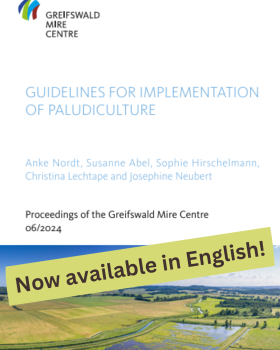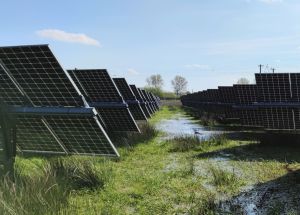News
March 2025
Newly translated into English!
by Helena Plochberger (comments: 0)
Guide to Implementing Paludiculture

20/03/2025 Our Guide to Implementing Paludiculture is now available in English - good news for people in sustainable agriculture and climate initiatives, in eco-aware businesses and other!
If you're looking to manage peatlands sustainably but unsure of where to begin, this comprehensive guide is your go-to resource. From assessing site suitability to navigating permits and optimizing biomass utilization, we've compiled practical insights to support your efforts.
This newly translated and formatted version is part of our GMC publication series, making it even more accessible for all stakeholders involved in sustainable land management. It is based on the original publication Leitfaden für die Umsetzung von Paludikultur, released in 2022.
MoorPower
by Helena Plochberger (comments: 0)
Solar on peatland feasible?

17/03/2025 Competition for land in Germany is fierce, but is it possible to combine uses such as photovoltaics and the rewetting of peatland? The newly launched MoorPower project is taking a close look at the general feasibility of solar pan elson peatland with simultaneous rewetting. It is also investigating whether this concept makes rewetting more attractive for farmers.
Since the beginning of 2023, the German government has been promoting the construction of solar systems on peatland that was previously drained for agriculture if it is permanently rewetted. The concept is new. So far, there is only one PV system on rewetted peatland known in Germany and none abroad. TThus, there is considerable need for testing and research in order to be able to assess possibilities and effects.
“It is important to develop only drained and heavily degraded peatlands, i.e. peatlands currently used for agriculture, for the dual use of carbon storage in peat and the production of renewable energy via photovoltaics. It must be prevented that peatlands are used for the installation of photovoltaic systems without being rewetted, because then the greenhouse gas emissions from the peatlands would continue,” said Prof. Dr. Jürgen Kreyling from the University of Greifswald. “Peatlands and peat soils of nature conservation value within legally protected areas are excluded.”
And this is what the research looks like in practice: On an experimental site in Mecklenburg-Western Pomerania, the scientists are building system designs on a total of six hectares of fen that is still used for agriculture, with different mounting heights, solar module types and foundations. They then combine each PV system variant with three different water levels and examine their ecological impact. The project team is testing different materials, coatings and methods for the foundations of the special PV systems on a material test area in Baden-Württemberg. As shade from the solar modules can have an impact on the growth of typical peatland plants, they are also investigating this in pot experiments. The scientists at the Thünen-Institute are analyzing the impact of peatland PV on the greenhouse gas balance on a practical scale on around 200 hectares of rewetted peatland with photovoltaics in Lower Saxony.
Research for MoorPower is jointly conducted by the Universities of Greifswald and Hohenheim Johann Heinrich von Thünen-Institute and the Fraunhofer Institute for Solar Energy Systems ISE.











